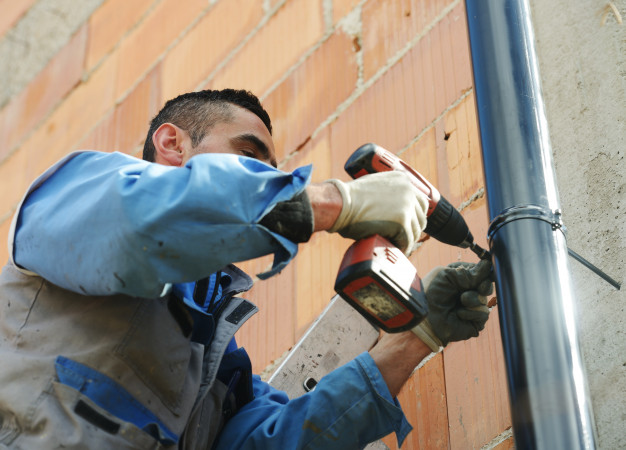How To Install Vinyl Gutters: A Step-By-Step Guide

Every house in this world requires an efficient water management system. Gutters are an important part of the drainage system of any property. However, with societal advancements, people often feel bothered by the question of how to install vinyl gutters in their homes? Even though rain gutters use all different kinds of materials such as aluminum, steel, or copper, for the composition vinyl pipes are a rising star in this aspect.
What Is A Vinyl Gutter?
Vinyl gutters basically use a material known as polyvinyl chloride(PVC) for its composition. This material is actually a synthetic plastic polymer. Being constructed out of PVC plastic, these gutters tend to be dent and corrosion-resistant.
Being a very light material, these gutters are easy to set up in homes. Their affordability in comparison is to other materials is also an advantage. Hence, due to all such quality features, these vinyl gutters are gaining much recognition among homeowners.
People generally use Vinyl gutters as a water discharge system and it works quite efficiently to channel out the water. I can understand you are getting curious to know how to install vinyl gutters. So, let us look forward.
Cost of Rain Gutters
An investment against the elements: Gutters are an investment to protect your home. Stylish half-round aluminum gutters cost $2.75 per linear foot. They are held in place by cast-aluminum brackets that cost $8 each and can be painted, if desired, for a special touch—such as an antique gold finish.
The system comes with 4-inch diameter corrugated aluminum downspouts that cost $1.75 per linear foot and are offered in any of the colors available to match your home’s trim.
Gutters must be pitched to the downspout for good water flow: For good water flow, gutters must be pitched ½ inch for every 10 feet to the downspout.
On gutter runs over 40 feet, pitch the gutter from the middle to downspouts at each end, or slope from both ends to a central downspout.
This ensures smooth water flow and helps protect the structure from water damage. Every house is different, so you must assess your home’s specific needs to determine the most appropriate gutter configuration for aesthetics and functionality.
Materials Required To Know How To Install Vinyl Gutters
- Extension ladder
- Tape measure
- Screwdriver
- Chalk line
- Drill
- Compass
- Hacksaw or jigsaw
- Deck screws
- Gutter hanging brackets
- Gutter sleeves
- Plastic gutter downspouts
- Connectors
- End caps
Steps For How To Install Vinyl Gutters?
1. Measuring & Purchasing
- Before you purchase all the materials, it is important to draw out the measurements of your house.
- Firstly, you should measure the eaves of the roof before fixing the gutter.
- One needs to measure, mark and note the lengths of every side and edge.
- One needs to Measure the angles around the edges and corners where the gutters need to be fixed using a compass.
2. Planning And Preparing
- Planning is a very integral part of any process.
- Decide where and how the water needs to be channelized.
- Consider the structure and layout of your home before initiating the plan.
- Get on a ladder and take a rough measurement of the length from the ground and the gutter run as well.
- Draw a layout for the plan of gutter installation.
- Include correct measurements.
- Decide whether to buy an entire kit or separate customizable parts for installation.
3. Decide Which Way You Want The Water To Glide
Decide when planning for gutter installation whether you will harvest rainwater in a barrel or divert it some distance away from the foundation of your home to avert leaks. Assess the layout of your property and the terrain to decide what path to take with the water running off your roof.
Divert the water at least 10 feet into your yard from the foundation of your house without letting it leak using downspouts. Make sure you have enough yard space to do this. You should also check the land for steeper angles or depressions where it can reverse the flow of water towards your home, which may cause water infiltration issues in the basement. You can protect your home from water-related problems with good planning.
4. Measure Out The Gutter Run
To accurately calculate the quantity of gutter sections and related components required, start by measuring the part of your house where gutters will be installed. This length is known as the gutter run. While it’s possible to estimate this measurement from the ground, for precision, it’s best to climb a ladder and measure the exact areas with assistance from someone. Accuracy is crucial.
Before purchasing, draft a diagram of your gutter setup. Outline the design and include precise measurements to facilitate an easy reference when shopping for materials. This preparatory step is essential for a successful gutter installation.
5. Installing Brackets
- Start constructing from the outer ends of the eave.
- The first bracket should be hung at the top of the eave.
- Using a drill, fix the brackets using 1.25-inch screws.
- Ensure to fix the brackets 3 feet apart from each other.
- Fix the gutter hangers.
6. Mark Fascia board slope with chalk line
Mark your slope on the gutters beforehand for an effective gutter installation. You can use a simple chalk line to indicate just where the water is supposed to flow. For vinyl gutters, it is recommended that you create a slope of about a quarter to half an inch for every ten feet of gutter; this should be good for the gutter lengths up to 30 feet.
This slight angle assures that water doesn’t stay stagnant but flows out smoothly. You can make the gutter sections over 30 feet have the highest point at the center of the gutter, allowing an even slope from the center towards both ends.
If the gutter run is over 40 feet, you would want to use a reverse slope, sloping down from both ends to a downspout in the middle. You can only do this after you have tailored the set to fit the specific needs of your home’s architecture, ensuring the proper flow of water before laying the final setup of the gutter components and layout.
7. Drilling
- Now you need to drill two holes for downspouts.
- Set the gutter sleeves towards the end of the outer corner pieces.
- Mark the outline of the sleeves with a marker for being able to make the cuts.
- Drill holes at the corner of the markings and cut out pieces using a jigsaw.
- Slide the gutter sleeves in from the above with the rest of the gutters and set the corner pieces in place.
8. Installing The Downspout
- Using a drill or screwdriver, attach the downspouts on the edges of the roof with 1.25-inch screws.
- You need to connect each piece of downspout to completely install the downspout pieces of guttering.
- The tapered ends of the downspout pieces must be slid into the wider ends.
9. Fixing The Gutters
- Using hangers to support various sections, fix the sections of the gutter into the outlets.
- Cut out the gutter sections using a saw to adjust its size for fitting along the walls.
- Join the gutter sections with connectors using a slip joint made up of a plastic material towards the end of every 10-foot length.
- The downspout outlet to the gutter to the outlet now needs to be secured.
- Next, the downspout elbows need to be joined to the outlet and its tubes arising above the gutter.
- Choose the proper size of the drainpipe section to fit in between the elbows.
- Using the same brackets used for the gutter sections, fix the drainpipe along the wall.
- Gutter guards are like jackets composed of metal mesh that rests over the gutter for completion of installation.
- This allows a smooth flow of water and prevents dust or dirt from clogging it up.
10. Managing And Maintaining
- It is quite essential to maintain an annual gutter cleaning schedule.
- This will make sure of efficient functioning of the system without anyone having to repair it.
- Having gutter guards reduces the effort to clean the gutters every now and then.
- Get on a ladder frequently and make sure to remove the fallen leaves and twigs that are clumping the gutter.
- Even try to remove or clean the downspout where large pieces of dirt might remain stuck.
- If there are serious clogging issues, try to gush down some water through the gutter using a hosepipe.
- You must also take a careful look and check for leaks or drips.
- To keep the gutters working well, get to fix or reconnect the loose sections with screws.
Final Thoughts
There you go with all the instructions that you needed to learn about how to install vinyl gutters. There are great reasons as to why you must set up vinyl gutters. This will not only act as a great water discharge system but also has many exclusive features. All these reasons make it the best choice for DIY gutters for homes.
However, once you enter the market, you must ensure that you are purchasing good quality vinyl material for your gutters. It is very simple to install. This way, you can skip massive assistance to fix it; in addition, you won’t also require any hefty expenses. So, when are you going to install your own vinyl gutter?
Read Also:
















Leave A Reply